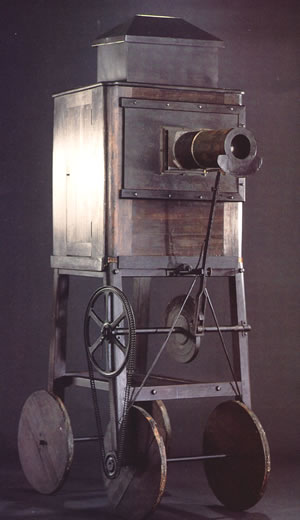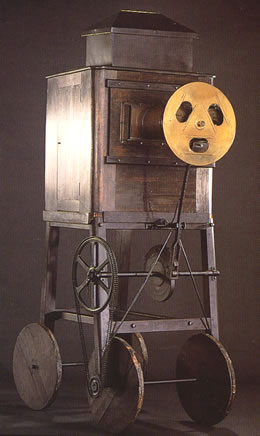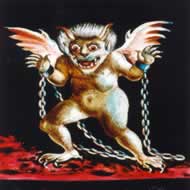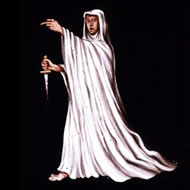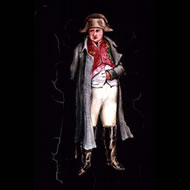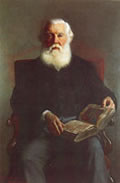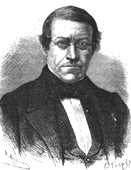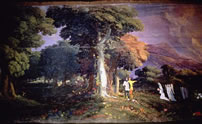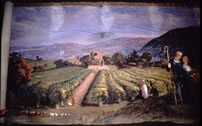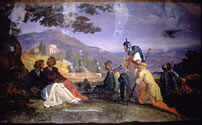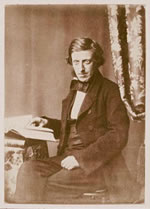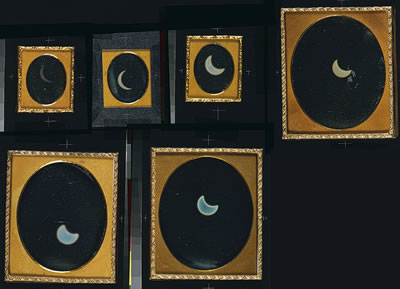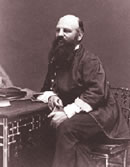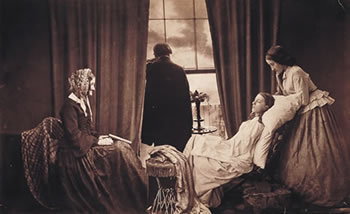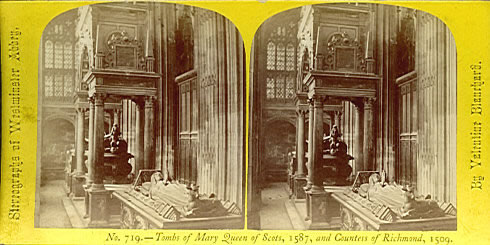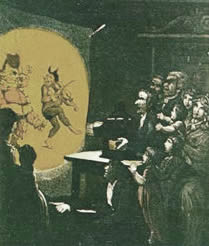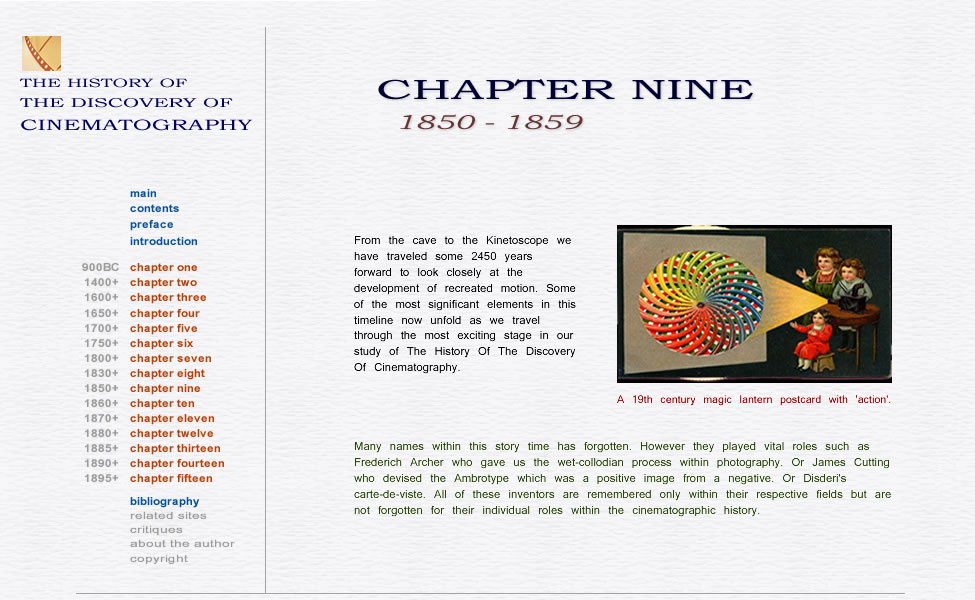 |
| |
|
|
|
| |
|
|
|
| |
1850
WILLIAM LANGENHEIM (1807 - 1874) |
|
|
| |
A new process of making
a positive image on a glass disk is announced by Langeheim, a transplanted
American from Germany. Alongside his brother Frederic, William's work
makes it possible for Plateau's Phenakistoscope, Stampfer's
Stroboscope and Muybridge's Zoopraxiscope
to receive photographs onto their disks with ease as well as the magic
lantern. The machine is the Hyalotype and processed glass
plate albumen-process slides. |
|
| |
|
|
|
| |
|
|
|
|
|
|
| |
|
|
|
| |
|
MOISSE
FANTASCOPE
In 1991, Thomas Weynants
along with three other colleagues, made an amazing discovery
in the Limousin region of France about 340km south of Paris.
Weynants found an optical
treasure known as a Fantascope (left)
in almost pristine condition. Clearly a fantasmagorie mobile
lantern from the early 19th century, its origin and exact date
of manufacture and original purchase have been difficult to
determine.
This precious magic lantern
instrument of the fantasmagoria was found in the castle Château
de Moisse near the village of Bétête and has been
named by Mr. Weynants as the Moisse Fantascope.
Also found were three different
lenses; a Fantasmagoria lens, a
Megascope lens, and a Dissolving
View lens-set (a double lens with individual cat-eye
accessories). Each of the individual lenses is mounted
on wooden board attachments for easy exchange.
Along with the lenses where
found twenty-three beautifully hand painted lantern slides.
As Weynants points out, "great
historic figures of the time were transformed into fantasmagoria
subjects via these handpainted slides, for example two portraits
of Bonaparte. Such historically important figures illustrate
another theme in the fantasmagoria. Other examples are portraits
of Marat, Robbespierre, Louis XVI, Danton, etc., which where
projected onto "smoke curtains” with the help of
a hidden lantern . . . . a further 4 hand-painted slides were
inspired by Greek Mythology, religion and gods (other important
inspirational sources for the fantasmagoria). for example, Hero
& Leandre, Hébé, l’Education d’Achille,
l’Enlevement de Dejanire."
A still further spectacular
projection accessory found at the Château was an animated
marionette 'skeleton' shown opening his tomb! For a complete
visually guided tour of this incredible find we encourage a
visit to Thomas Weynants wonderful website Phantasmagoria
Introduction - The Moisse Fantascope Discovery in twelve
parts. Mr. Weynants has made his discovery available to the
Passion Cinema Exhibition at the Paris Filmmuseum where it is
now on extended loan.
|
| The
Moisse Fantascope with fantasmagoria lens in place |
Images
Courtesy The Thomas Weynants Collection |
| |
|
| |
|
| Below
we see the Moisse Fantascope fitted with each
set of lens attachments (dissolving view / dissolving view
lens and disc / megascope lens). |
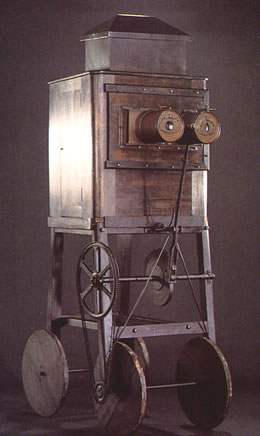 |
|
|
The
Moisse Fantascope with dissolving view lenses attached
showing the cat-eyes (above-left) |
The
Moisse Fantascope with dissolving view lenses and disc
attachment (above-centre) |
The
Moisse Fantascope with megascope lens attachment
(above-right) |
|
| |
|
|
On the subject of who built this Fantascope,
the 'probable' short list would include Lerebours, Dubosq, Molteni
or Chevalier. There are no apparent identifying features on
the instrument to aid in this mystery. It does however have
a mechanical autofocus mechanism connected from the lens down
to the wheels. This feature allowed the lanternist to 'dolly'
forward or backward while keeping images in sharp continuous
focus.
Weynants expands on this auto-focus technique by stating,
"In order to achieve this the fantasmagoria lens is used,
and connected to the wheel operated mechanism wich regulates
the distance between the movable front lens and the fixed condenser.
This results in a focused image on the screen regardless of
the size of the projected devil or distance between the fantascope
and the screen. By increasing the distance between screen and
fantascope during complete darkness, the result is the illusion
of an approaching devil."
"The different parts of the
mechanical autofocus system and how it is synchronized with
the front optical element of the Phantasmagoria lens, eventually
leading to the wheels. Because the system regulates the focus,
the result in total darkness is a projected zoom-effect. For
this application (the projection of opaque objects) the Megascope
lens is mounted on the Fantascope. With this adaptation the
name of the apparatus simply changes into Megascope (better
known as an Episcope). The idea for this peculiar technique
and fantasmagoria application was inspired by Jacques Alexandre
César Charles who originally used the Megascope for scientific
purposes during lectures."
Leonard Euler in 1756 (SEE EULER
1756) was the first to reference the use of the Megascope
in conjunction with the Fantascope. |
| |
|
| |
|
|
|
| Four
of the twenty three beautifully hand-painted Fantasmagoria
lanternslides (below) found with the Fantascope
at the Château de Moisse |
 |
|
|
|
Hébé
|
Diable
(Devil) |
La
Nonne Sanglante (The bleeding Nun) |
Napoleon |
|
| |
|
The
term Phantasmagoria comes to us from the middle
English noun 'fantasme' (the Anglo-French is 'fantosme'
or 'fantasme') and the Latin 'phantasma', meaning
"to present to the mind a product
of fantasy". It also refers to a "delusive
appearance" and "a
figment of the imagination" or a "mental
representation of a real object".
Subjects within Fantasmagoria shows fell under
ghoulish or diabolic themes; witches, devils, ghosts and ghouls,
the dead-come-to-life, phantoms, skeletons, life-in-the-graveyard,
skulls, mythical Greek characters like Hébé
and Hero, and figures (typically the heros) of the
French Revolution. The purpose of the Phantasmagoria
was to scare the audience to death. It can be considered the
forerunner of today's horror movie.
Thomas Weynants' website A
History of Early Visual & Popular Media not only has
a wonderful history of pre-cinema and photography, but also
a very in-depth description and history of the Phantasmagoria.
His site Phantasmagoria
Introduction - The Moisse Fantascope Discovery details the
finding of the Moisse Fantascope including a fully illustrative
blend which includes all the accessories and slides found with
this marvelous discovery. |
| |
|
|
|
| |
|
All
Images Courtesy The Thomas Weynants Collection |
|
| |
|
|
| |
|
|
| |
|
|
| |
1850
Sir AUSTEN HENRY LAYARD (1817 - 1894)
An archaeologist, Layard
excavates the remains of Babylon in 1850 and describes a rock-crystal
find dating back to this period (the first lenses).
Layard shook the world
a year earlier (1849) when he unearthed Nineveh.
An 1885 portrait
of Layard (right) by Charles Vigor. Image source: British
Museum |
|
|
|
| |
|
|
|
| |
|
|
| |
|
|
|
| |
|
|
|
| |
1850
LOUISE DESIRE BLANQUART-EVRARD (1802 - 1872) |
|
|
| |
Announces an albumen paper
process, which would end up being, used the world over for the next half
century. This process of photographic prints on paper used albumen from
the white of eggs which allowed a smoother finish on paper. |
|
| |
|
|
|
| |
|
|
|
| |
|
|
| |
|
|
| |
|
1850
(SIR) CHARLES WHEATSTONE (1802 - 1875)
Wheatstone
improves on his Stereoscope and takes it to Paris
for a showing. Stereoscopic photos are taken especially for it.
|
Charles
Wheatstone |
|
|
|
| |
|
|
| |
|
|
| |
|
|
| |
|
|
| |
1850 - THE GRAND
MOVING PANORAMA OF PILGRIM'S PROGRESS
In 1996, Tom Hardiman
discovered a portion of The Grand Moving Panorama
of John Bunyan's Pilgrim's Progress, (painted c.1850-1851),
at the York Institute in Saco, Maine. Curator of the Institute,
Hardiman stumbled upon two large sections of this very famous
(in it's time) Moving Panorama. Found in
the basement of the Institute, the Panorama
in its original state would have been eight feet tall by approximately
900 feet long. This find is the only extant version of Pilgrim's
Progress. It was thought lost for over a century.
The canvas has been restored
at the Williamstown Art Conservation Center in Williamstown,
Massachusetts. Bunyan's Pilgrim's Progress was published in
two parts, first in 1678 and then in 1684. This seventeenth-century
allegory tells the story of the main character Christian,
on his pilgrimage to his eternal reward, Heaven.
|
| |
|
|
|
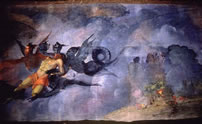 |
|
|
|
They
Beheld the Fate of the Apostle |
|
They Arrive at the Delectable
Mountains 1
|
They Arrive at the Delectable
Mountains 2
|
| |
|
|
|
| View
A Larger Digitized Image Of These Paintings Joined Together Here |
|
| |
|
|
|
| |
|
|
|
| These
individual scenes from the two large sections discovered of The
Grand Moving Panorama of John Bunyan's Pilgrim's Progress,
include (from left to right); They Beheld the Fate of the
Apostle (far left), Land of Beulah (centre-left),
They Arrive at the Delectable Mountains sc.1(centre-right),
and finally, They Arrive at the Delectable Mountains
sc.2 (far right). |
| |
|
|
|
This
particular Moving Panorama was close to two
hours in length when viewed professionally and was accompanied,
which most Panoramas were, by a lecturer who
described the scenes, told the story, and acted more or less
as a guide. Many also had music. Although this Panorama
had been given to the Institute in October, 1896, it had slowly
been forgotten for exactly 100 years. The canvases were found
in a section of the basement. One of the sections found was
approximately 500 feet long and the other, 400 feet.
Joseph Kyle and Jacob Dallas, members of National Academy of
Design in New York City, are the names most often associated
with The
Grand Moving Panorama of John Bunyan's Pilgrim's Progress.
However, many of the designs for the Panorama
and the actual painting were done by the noted painters of the
day; Frederic E. Church, J. F. Cropsey, and Daniel Huntington.
These paintings hold more than forty scenes. Some are from twelve
to thirty feet wide. Well-known figures from the Holy Scriptures
are shown against beautiful landscape scenes as recorded in
Bunyan's classic story. These shows can't help but remind us
of the early work of David Wark Griffith, and Cecile B. Demille. |
| |
|
|
|
| Panoramas
as well as Moving Panoramas were given reviews
by the newspapaers, as films are today. |
| |
|
|
|
|
|
| |
|
|
| |
|
|
| |
|
|
| |
1851
FREDERICK SCOTT ARCHER (1813 - 1857)
With an exposure between
10 and 90 seconds, Archer introduces the Wet-Collodion
(wet plate) process. Archer‚€™s collodion contained
potassium iodide and was dipped in nitrate of silver prior to
placing in the camera.
This technique on glass
will be the process-of-choice for the next twenty years. Archer
died penniless but his estate was given a Crown pension fifty
pounds annually.
Frederick
Archer (right) preferred to share his findings and
discoveries with the photographic world first, before heading
to the patent office.
|
|
|
|
| |
|
|
|
| |
|
|
| |
|
|
|
| |
|
|
| |
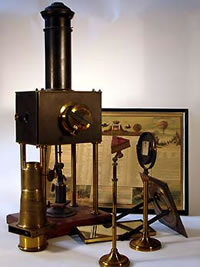 |
1851
JULES DUBOSEQ [DUBOSCQ] (1817 - 1886)
Duboseq, a lantern maker
and optician, designs and builds a machine he calls a Stereoscope
and obtains a patent for it.
He also builds a superb
lantern capable of viewing microscopic documents known as the
Lanterne Photogénique.
Duboseq also researched
different apparatus in hopes of demonstrating optical phenomena.
Duboseq's Lanterne
Photogénique (left)
Image Source: ANTIQ-PHOTO |
|
|
| |
|
|
|
| |
|
|
|
| |
|
|
| |
|
|
| |
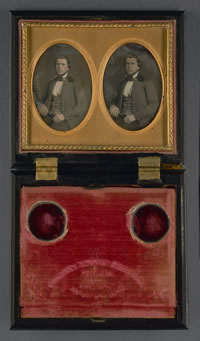 |
1852
JOHN FREDERICK MASCHER ( - )
Mascher obtains a stereoscopic
Daguerreotype. He describes his half-plate
Daguerreotypes in a stereoscopic box called a Mascher
Viewer, in the magazine 'Scientific American'.
The viewer held two
stereo photos as well as two lenses for proper depth illusion.
He patents his viewer this year.
This Mascher Stereoscopic
Viewer (left) is ca. 1854-1855. The two Daguerreotypes
were seen through two lenses placed in the lower lid. When raised,
the viewer would look through the lenses and see what appeared
to be a far more 'life-like' image of the subject.
This Daguerreotype
features a distinguished gentleman, identified as a likely 'pioneer'
to California. Mascher was a Philadelphia photographer.
Image source
(left): University of California calisphere
Digital Library
Zelda Mackay Pictorial Collection, Bancroft Library |
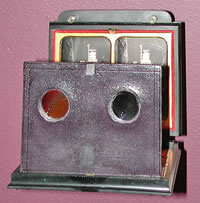
|
The
Mascher Viewer above shows the device in it's
opened state, ready for viewing.
Image
source (above): Mike Robinson, Photographic Historical
Society of Canada |
|
|
| |
|
|
|
| |
|
|
| |
|
|
|
| |
|
|
|
| |
1852 |
|
|
| |
With the negative-less
Daguerrean system, prints, enlargements and reductions were not possible.
However, with the Wet-Collodion process these were all
now possible. The process is published this year and becomes widely known. |
|
| |
|
|
|
| |
|
|
|
| |
|
|
| |
|
|
| |
1853
BARON FRANZ VON UCHATIUS (1811 - 1881)
Uchatius
reverted back to his original idea of nineteen years earlier. He
rotated the light source as opposed to the images. Using a crank
and upgrading once again the illumination, this time to limelight,
Uchatius cranked picture after picture, giving a strong impression
of movement. A lens was positioned in front of each drawing on the
disk and as the disk was revolved, the light moved with the image.
This was how he originally had envisioned his device to work (moving
his light source behind each drawing instead of moving the images,
SEE UCHATIUS 1834). Uchatius
was a lieutenant in the Austrian forces at the time and presented
his device to the Vienna Academy of Sciences. As
opposed to the Fantoscope and Stroboscope,
Uchatius‚€™s machine, known as the Lantern Wheel of Light,
could entertain many at one time which is what it was meant to do
as a military teaching instrument. There is some question as to
whether or not Ludwig Dobler, a Vienese purchased the 1845 or 1853
model. As a magician, Dobler traveled Europe giving 'motion picture'
shows. |
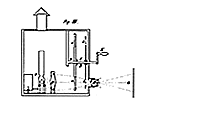
Lantern
Wheel Of Light 1845
|
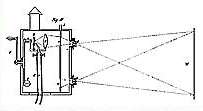 Lantern
Wheel Of Light 1853
Lantern
Wheel Of Light 1853 |
| |
| What
made the 1853 device superior was the rotating light source. In
the 1845 version the images were revolved but Uchatius changed that
and circulated the limelight source behind each drawing just like
passing the torch (?) behind those lanterns in 1834. Notice the
difference in size between the two projected images (above left
& right).The drawings and description of the two machines
were published in the 1853 Vienna Academy of Sciences Journal.
The effect of the 1853 machine is reminiscent of the Dissolving
Views and may have played a part in it's creation. With
the greater illumination and better throw upon the screen, Uchatius
was able to project an image which was reported to have been better
than 6X6 feet (as opposed to the six inch demonstration of 1845)
[Liesegang sources von Lenz and reports a dimension of 2 by 2.5
metres]. Considering his interest in motion recreation only a hobby,
he was also a photographer, chemist, physicist and maker of cannons
for the Vienese military. Uchatius took his own life in 1881.
(Diagram Sources: Adventures In Cybersound). |
|
|
| |
|
|
| |
|
|
| |
|
|
|
| |
|
|
|
| |
1853
ADOLPHE ALEXANDRE MARTIN (1824 - 1896) |
|
|
| |
Another modification
of the Ambrotype is the Tintype process,
introduced by Martin this year. The Tintype (also
known as a Ferrotype), is usually created on a sheet
of metallic metal, not glass. The metallic plate would then be sensitized
by coating it with collodion prior to using. At the time, a new and popular
process. |
|
| |
|
|
|
| |
|
|
|
| |
1853
ACHILLE QUINET (1831 – 1900) |
|
|
| |
Quinet presents the first
binocular style stereo camera and calls it a Quinetoscope. |
|
| |
|
|
|
| |
|
|
|
| |
1853
JOHN BENJAMIN DANCER (1812 - 1887) |
|
|
| |
Dancer, an Englishman
from Manchester introduced the first twin-lens stereoscopic camera. |
|
| |
|
|
|
| |
|
|
|
| |
|
|
| |
|
|
|
| |
| 1854
WILLIAM LANGENHEIM (1807 - 1874)
FREDERICK LANGENHEIM (1809 - 1879)
The first total eclipse
of the sun, which was visible to North Americans since the discovery
of Photography, occurred on 26 May 1854. The
Langenheim brothers where there to photograph the eclipse, taking
eight Daguerreotypes in sequence. Only seven
survive, six of which are shown here (right).
Other photographers
of the day also took sequential pictures as did the Langenheim's
(of Daguerreotypes and Calotypes)
but none are known of today.
The Daguerreotype
which is not shown in this exhibit at the Metropolitan
Museum of Art is the eighth image. It is believed to have been
made on a smaller plate size and because a small camera was
used due to lesser light available during an eclipse, it revealed
no image (a total eclipse) at that point in the transit. |
|
|
|
| |
Six of seven extant
Daguerreotypes taken by the Langenheim Brothers 26 May 1854
From Philadelphia, Pennsylvannia. Image Source: The Metropolitan Museum
Of Art
|
|
| |
|
|
|
| |
|
|
| |
|
|
|
| |
|
|
|
| |
1854
ARTHUR JAMES MELHUISH (1829 - 1894) |
|
|
| |
Melhuish receives a patent
for a roll holder of sensitized paper. |
|
| |
|
|
|
| |
|
|
|
| |
1854
JAMES AMBROSE CUTTING (1814 - 1867) |
|
|
| |
An unsettled spirit in
many ways, Cutting created the Ambrotype (taken from
his middle name) which was a glass negative viewed as a positive. He receives
a patent for it as well as for the use of bromide in collodion. He then
forfeits his patent rights, moves and builds an aquarium in Boston, which
eventually becomes the Aquaria Gardens. He also designed a new kind of
beehive. |
|
| |
|
|
|
| |
|
|
|
| |
|
|
| |
|
|
| |
| 1854
ANDRE ADOLPHE EUGENE DISDERI (1819 - 1890)
His Carte-de-Viste
system uses between 8 to 12 lenses taking photos on one plate.
The Carte-de-Viste was a type of calling card
approximately 2.5 by 4.5 inches holding a number of images on
one plate. Disderi's CDV's became popular by the 1860‚€™s due
to the fact Napoleon III had been near Disderi’s studio
and had his photograph taken by Disderi. The notoriety and publicity
of this event set him up in the photographic world for life.
Disderi's studio became
known as the 'Palace of Photography' and had had almost 100
workers producing thousands of CDV's every day. Photographic
mass production had begun. When the Cabinet Card
Photograph replaced the CDV, Disderi tried
other formats, but was unsuccessful. He died broke, deaf and
blind. |
|
|
|
| |
|
|
|
| |
|
|
|
| |
|
|
| |
|
|
|
| |
|
|
|
| |
1855
ALPHONE LOUIS POITEVIN (1819 - 1882) |
|
|
| |
Poitevin was a printmaker,
photographer and chemical engineer who introduced the Collotype
and carbon-print process as well as Photolithography. |
|
| |
|
|
|
| |
|
|
|
| |
1855
A. RELANDRIN ( - ) |
|
|
| |
Another film roll holder
is introduced in France. |
|
| |
|
|
|
| |
|
|
|
| |
|
|
| |
|
|
| |
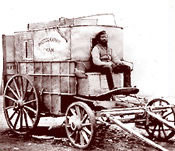 |
1855
ROGER FENTON (1819 - 1869)
Fenton
takes the newly created role of photojournalist to the next plateau
by returning from the Crimean War with in excess of 350 plates of
history. By photographing the Crimean War in 1855, Roger Fenton
became the first photographer to photograph actual hand-to-hand
combat. Fenton was English and was granted permission to photograph
the Royal Family. Fenton's pictures remain unseen by the masses
because newspapers do not yet have the capability to publish photographs.
One of
Roger Fenton's photographs taken in the Crimean War (left). |
|
|
| |
|
|
| |
|
|
| |
|
|
|
| |
|
|
|
| |
1856
THOMAS SKAIFE (1806 - 1876) |
|
|
| |
This Englishman designed
the first pistol-shaped camera and is arrested when aiming it at Queen
Victoria to obtain a picture of her. |
|
| |
|
|
|
| |
|
|
|
| |
1858
JAMES AMBROSE CUTTING (1814 - 1867) |
|
|
| |
Cutting develops a Lithography
process whereby photographic negatives can be used for paper reproduction
positives. |
|
| |
|
|
|
| |
|
|
|
| |
|
|
| |
|
|
| |
1858
HENRY PEACH ROBINSON (1830 - 1901)
In
this year, Robinson, who was a professional photographer for only
seven years (1857-1864), gave us the world's first Composite
Photograph - that of a young woman on her deathbed. A
photomontage, or composite photo, is created by using two or more
negatives to create the desired positive. In modern cinematographic
terms the traveling matte or matte photography was developed from
this theory and the work of men like Robinson.
This particular photograph (right) by Robinson used 5
separate negatives. |
|
| Henry
Peach Robinson's photomontage (right) was called 'Fading
Away'. The subject of and production of post-mortem-photographs
was not for everyone. Robinson developed a negative physical reaction
to the photographic process brought on by some chemicals used
and was forced to retire from the business. |
|
|
| |
|
|
| |
|
|
| |
|
|
|
| |
|
|
| |
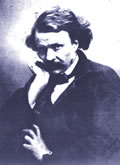 |
1858
GASPARD FELIX TOURNACHON (also NADAR) (1820 – 1910)
This Frenchman adds
another first in the journals of photojournalism. He takes flight
in a hot air balloon and while over Paris, takes the world‚€™s
first aerial photo.
Gaspard Felix
Tournachon (left) |
|
|
| |
|
|
|
| |
|
|
| |
|
|
| |
|
|
| |
1858
GEORGE SWAN NOTTAGE (1823 - 1885) LONDON STEREOSCOPIC COMPANY
Manufactures a Stereoscopic
Camera that will fit in a man or lady‚€™s pocket. It measures
8 by 4 3/4 inches and is 2 inches deep. Nottage began the London
Stereoscopic Company, in 1854. Their specialty was the mass production
of stereoscopic photographs. The company by 1856 had produced
an estimated one-half million Stereoscopes and
Stereo Cards. The demand was so immense that
by this time, The London Stereoscopic Company claimed to possess
at least 10,000 titles in its inventory. By 1858, Nottage had
100,000 stereo cards in stock. Stereoscopic Photography
was at it's height. |
| |
|
|
| |
|
|
| |
This
stereoscopic view (above) from The London Stereoscopic
Company's archives shows two tombs within Westminster Abbey; Mary
Queen of Scots - foreground (d.1587) and Lady Margaret
Beaufort (The Countess of Richmond d.1509). Photographer
Valentine Blanchard took these pictures. |
|
| |
Image
Source: Stereoviews |
|
| |
|
|
| Today,
Getty Images own over 40,000 glass-plate negatives from The
London Stereoscopic Company archives, which went out
of business in 1922. In its heyday, it was the largest busines
of it's kind in England and perhaps the world, with offices around
the globe. Unfortunately, many of it's glass plate negatives,
the size of window panes, had been re-used to make greenhouse
glass. |
|
|
| |
|
|
|
| |
|
|
| |
|
|
|
| |
|
|
|
| |
1858
JOSEPH D'ALMEIDA ( - ) AND LOUIS ARTHUR DUCOS DU HAURON (1837 - 1920)
Du Hauron had been working
on using filters for color separation and along with D'Almeida produced
separated lantern slides using red and green filters on the lenses. They
gave a lantern presentation handing out makeshift glasses to their viewers
with red in the left eye and green in the right. This is the first 3-D
or anaglyph Magic Lantern show we know of.
|
|
| |
|
|
|
| |
|
|
|
| |
|
|
|
| |
1858
CHARLES CHEVALIER (1804 - 1859) |
|
|
| |
Chevalier later went on
to make lenses for Daguerre. It consisted of very thin moveable blades
of metal secured within the lens so as to allow the aperture to open or
close. In 1858 Chevalier makes a claim that he used an iris diaphragm
18 years earlier (1840). Nicephore Niepce had used an iris diaphragm.
Iris diaphragms are used to this day. |
|
| |
|
|
|
| |
|
|
|
| |
|
|
| |
|
|
| |
1858
OPTICAL LANTERN ENTERTAINMENT . . .
.
. . changed a great deal in the mid to later half of the 19th century
with the popularity of the Photograph. With the
advent of Chromolithography in or around 1837,
slides could be printed therefore providing a superior quality image.
More so, the subjects began to include scenes from the Scriptures,
travelogues, and vocational scenarios. As a prelude to the 20th
century Motion Picture, lantern shows in the 19th
century depicted historical events and news items, popular fiction,
natural history and educational themes.
Then the photograph made it‚€™s introduction in 1858, as a new format
for the lanternslide. The majority of slide manufacturers from that
point began to produce photo-slides, replacing the poorer-quality
hand-drawn and painted slides. As the 19th century drew on, lanternslides
maintained their popularity as a family and public draw, especially
throughout the last two decades of the century. Lanternslides of
the era are still abundant for collectors to find even to this day. |
|
|
|
| |
|
|
| |
|
|
| |
1859
THOMAS SUTTON (1819 - 1875)
Sutton
develops a wide-angle photographic 'liquid' lens (Panoramic Lens).
Sutton was the co-founder and editor of an English magizine known as the
"Photographic Notes" who he co-founded with Louis Désiré
Blanquart-Evrard. The lens was a glass sphere that was filled with water
thus producing a 120 degree image, and the panoramic view. This concept
was not new. SEE ROBERT GROSSETESTE |
|
| |
|
|
| |
|
|
| |
|
|
|
| |
|
|
|
| |
|
|
|
| |
|
|
|
| |
|
|
|
| |
|
|
|
| |
|
|
|

|
| |


